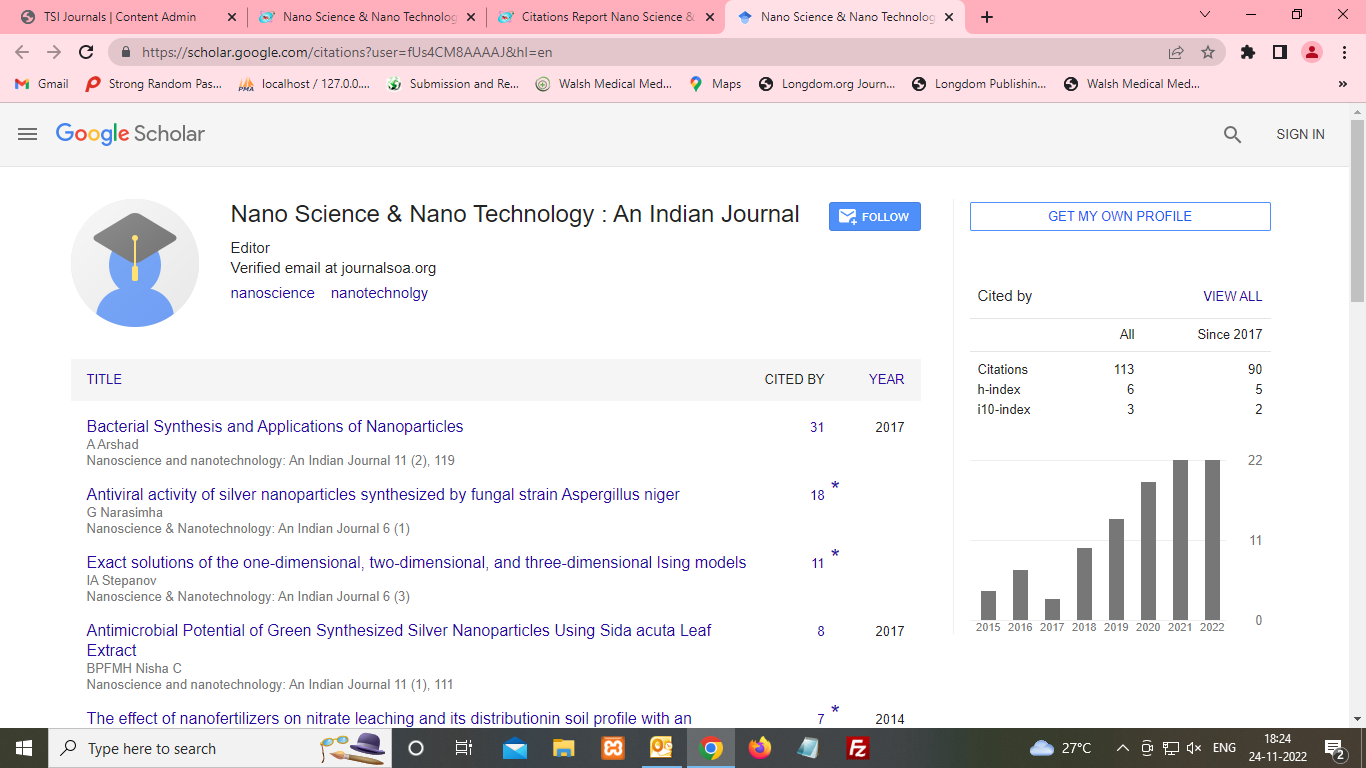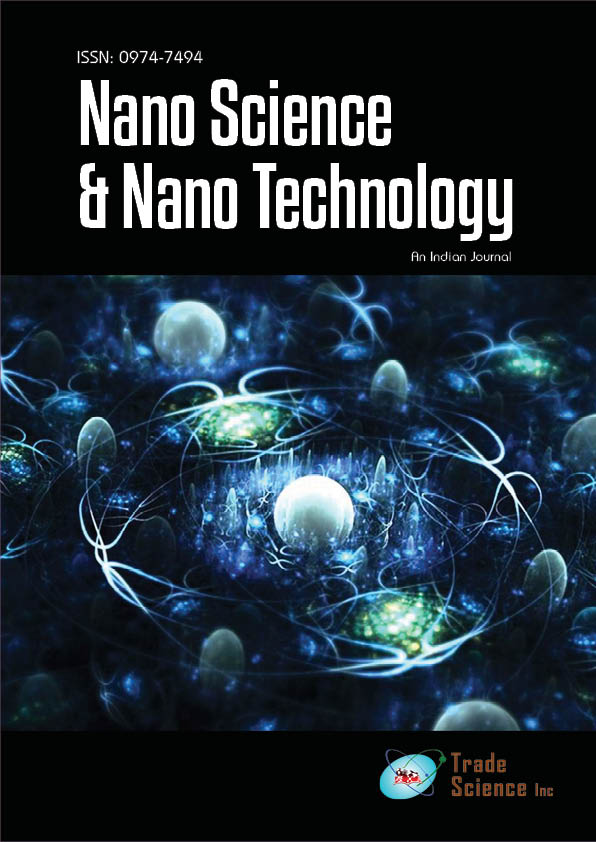Current opinion
, Volume: 16( 3) DOI: 2022; 16(3):152The Application of Nanotechnology to the Lengthening of the Shelf Life of Green Vegetables
- *Correspondence:
- Kane Adams Editorial office, Nanoscience & nanotechnology: An Indian Journal, UK. ; E-mail: info@tsijournals.com
Citation: Adams K. The application of nanotechnology to the lengthening of the shelf life of green vegetables. Nano Tech Nano Sci Ind J. 2022; 16(3):152.
Abstract
The elimination of harmful organic pollutants existing in the environment, particularly in water sources, as a result of human productive activities has become a major research area focused on developing sustainable water treatment systems and procedures. With over 10,000 varieties of commercial dyes and 70,000 tons of trash created yearly, the leather, paper, plastic, and textile sectors employ dyes to color their goods while utilizing huge amounts of water. This discharge of wastewater into natural streams causes substantial issues, such as increased toxicity and oxygen demand in the effluents, as well as a reduction in the quantity of light that can flow through the water, negatively impacting aquatic life's photosynthesis. Because of the high molar absorptivity coefficients of dyes (1 ppm), the presence of modest concentrations of dyes (1 ppm) is extremely apparent and undesired.Introduction
The elimination of harmful organic pollutants existing in the environment, particularly in water sources, as a result of human productive activities has become a major research area focused on developing sustainable water treatment systems and procedures.
With over 10,000 varieties of commercial dyes and 70,000 tons of trash created yearly, the leather, paper, plastic, and textile sectors employ dyes to color their goods while utilizing huge amounts of water. This discharge of wastewater into natural streams causes substantial issues, such as increased toxicity and oxygen demand in the effluents, as well as a reduction in the quantity of light that can flow through the water, negatively impacting aquatic life's photosynthesis. Because of the high molar absorptivity coefficients of dyes (1 ppm), the presence of modest concentrations of dyes (1 ppm) is extremely apparent and undesired.
TiO2 production
The sol-gel technique was used for TiO2 production. To dissolve 16.6 ml of titanium isopropoxide, a combination of 100 mL ultrapure water and 27 mL isopropanol was used, with steady stirring for 20 minutes. Following that, 3.1 mL HNO3 0.032 M (acid synthesis) was added and the solution was held at 80°C for 20 hours under continual stirring. Finally, the gel was heated for 4 hours at 560°C in a muffle furnace before being allowed to cool at ambient temperature to recover the solid TiO2.
Raschig Rings with TiO2 Support: 50 Raschig rings were put into a crystallizer containing 0.25 g of polyethylene graft maleic anhydride (PEGMA) totally dissolved in 25 mL of hexane, and the temperature was elevated to 70°C to accomplish the entire evaporation of the solvent. The dried rings were suspended in an aqueous TiO2 solution (10 g/L for the synthesized TiO2 catalysts and 1 g/L for commercial TiO2 samples) for 30 minutes. The solvent was then evaporated by heating the suspension at 150°C for 2 hours in a muffle furnace, followed by the elimination of the remaining organic materials by heating at 500°C for 2 hours.
The inclusion of additives alters the kinetics and efficiency of TiO2-catalyzed Rh6G photodegradation, especially when white light is utilized, indicating a complicated phenomenon. However, the stability of the supported photocatalytic systems is acceptable in the presence of the examined additives. Accordingly, the amount of the chemical oxygen demand shows that, despite the various complicated photophysical processes at work, the intermediate products of the photocatalytic systems under consideration appear to be comparable.
At nanomolar concentrations, hydrogen peroxide can function as a scavenger of electrons from TiO2's conduction band, promoting charge separation and the generation of hydroxyl radicals, which might contribute to the increased degradation of Rh6G. However, our system shows a reduction in photodegradation efficiency, indicating that the electron and/or hydroxyl radical scavenging characteristics of hydrogen peroxide may be relevant at the H2O2 concentrations investigated. When UV light (365 nm) is used to irradiate an Rh6G solution, a 22% degradation rate is observed, which is increased further in the presence of supported TiO2catalysts, with Degussa P25 degradation efficiencies exceeding 70% and Anatase and AS-TiO2 degradation efficiencies exceeding fourfold the degradation. The 25 g parsley samples were sealed in tiny glass jars (0.7 L). For 10 and 23 days, daily gas exchange measurements (CO2 and O2 concentrations) were taken. Using a special syringe, one millilitre of the gas sample was extracted and injected into a Perkin-Elmer 8700 gas chromatograph with a Thermal Conductivity (TC) Detector. After the jars had been closed for 1 hour, the first measurement (day-0) was taken. Three replications were employed for each chemical application. In total, 12 packages were investigated. Six packages (3 for each of the two compounds) were kept at 20°C, while the others were stored at 5°C in a cold storage room. These temperatures were chosen based on standard marketing circumstances. The vitamin and nutritional content of Petroselinum crispum (Mill.) is quite high. It has the greatest levels of calcium, iron, and folate of any vegetable investigated, as well as the highest levels of β-carotene, thiamin, riboflavin, vitamin C and vitamin E. Chemical compounds in parsley have anti-cancer and anti-heart disease properties. Its edible leaves is used as a garnish and culinary component and is planted as an annual. Freshness, green colour, lack of flaws or seed stems, and lack of rot are among quality characteristics for parsley (USDA 2002). For commercial storage of parsley, the suggested conditions are 0°C with 95%–100% RH for 35 days at 5°C with acceptable firmness and vitamin C content using a 40 m-thick ceramic screen.

